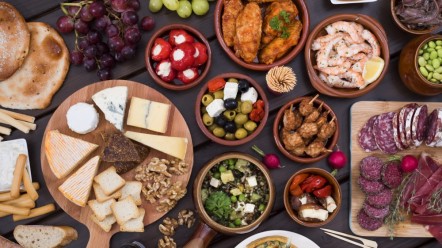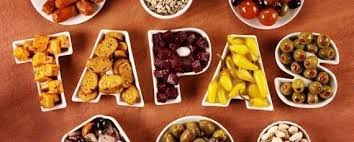ORIGIN
Though the primary meaning of tapa is cover or lid, it has in Spain also become a term for this style of food.
The origin of this new meaning is uncertain but there are several theories:

- A commonly cited explanation is that an item, be it bread or a flat card, etc., would often be placed on top of a drink to protect it from fruit flies; at some point it became a habit to top this “cover” with a snack.
- It is also commonly said that since one would be standing while eating a tapa in traditional Spanish bars, they would need to place their plates on top of their drinks to eat, making it a top.
- Some believe the name originated sometime around the 16th century when tavern owners from Castile-La Mancha found out that the strong taste and smell of mature cheese could help disguise that of bad wine, thus “covering” it, and started offering free cheese when serving cheap wine.
- Among the Portuguese region of eastern Alentejo, it is claimed that shepherds used to cover jugs of fresh water or wine with bread slices to protect it from snakes while on the field. This bread was finally eaten with chorizo or morcela upon return from herding.
- Others believe the tapas tradition began when king Alfonso X of Castile recovered from an illness by drinking wine with small dishes between meals. After regaining his health, the king ordered that taverns would not be allowed to serve wine to customers unless it was accompanied by a small snack or “tapa”.[9]
- Another popular explanation says that King Alfonso XIII stopped by a famous tavern in Cádiz (Andalusian city) where he ordered a cup of wine. The waiter covered the glass with a slice of cured ham before offering it to the king, to protect the wine from the beach sand, as Cádiz is a windy place. The king, after drinking the wine and eating the tapa, ordered another wine “with the cover”.[10]
- A final possibility surrounds Felipe III, who passed a law in an effort to curb rowdy drunken behavior, particularly among soldiers and sailors. The law stated that when one purchased a drink, the bartender was to place over the mouth of the mug or goblet a cover or lid containing some small quantity of food as part of the purchase of the beverage, the hope being that the food would slow the effects of the alcohol, and fill the stomach to prevent overimbibing.

TAPAS TODAY
Today having tapas is known as a version of eating out, this style becoming so typical that consumers have started to replace long and formal meals with informal and sociable tapas. In Spanish, to eat tapas even has its own verbs; picar means “to pick at” and is used to describe the way you would eat finger-foods, while tapear is a verb specifically meaning “to have tapas”.
You will also find that tapas follow the gastronomic tastes and traditions of each region in Spain, but that types of olives, nuts, meats and cheeses are universal to all areas.
In addition to these typical tapas there is a world of possibilities in the form of different recipes that tapas bars across Spain have mastered, encompassing ingredients including meats, fish, vegetables, eggs and many other foods served in small forms.
Tapas are of great culinary importance in Spain. The truth is that this type of eating has become a form of national identification and of cultural importance for all.
Spanish cities are constantly competing to be known as one of the best places to have tapas and there are countless lists of best tapas bars by city available across the web.
I’m sharing couple of places in 3 big cities in Spain that I personally visited and enjoyed!
MADRID

My number one is Mareas Vivas.
This place is located near Callao (in the city center) it’s a little bar with old style decoration. I recommend you to go early or you won’t find place! It’s a great place to hang out with friend, which every drink they will give you a free big tapa!
There are 3 markets that have been rebuild and made as a tapa’s market, I recommend you all.
- Mercado de San Miguel, located next to Plaza Mayor, it’s the main one, it’s always busy but there is a nice selection of food & drinks (it’s expensive).
- Mercado de San Ildefonso, located in the city center too in the centric street of Fuencarral, it’s a smaller place with some food stations. There is some food with a fusion twist. You will find more locals there.
- Mercado de San Anton, in the heart of Chueca district, it’s as well a smaller market where you can buy organic products as well as tasting fresh and delicious tapas!
La Taverna de la Daniela, there are different locations all in the city center. Their canyas (small fresh beer) and tapas are amazing! You must try the croquetas.
Casa Alberto, in Huertas area. It’s one of the oldest places where famous writers and artists use to go.
There is a lot of places everywhere, the best is to start in one and walk to the next one and so on!
Sharing with you a link to Tripadvisor recommendations.
SEVILLA
I recently visited the city and I could discover the following places:
Eslava,The place is not in the city center but is worth a visit! All the seafood and tapas were delicious! The place is small and it’s very difficult to get a spot!
Casa Ricardo, very famous for their croquetas, the decoration is cool like a old style bar.
Universal People Bar, Located in the center, it’s a new place but the food was absolutely amazing specially the Ox tail stew!
El Mercado de Triana, probably the best market in Sevilla where you can buy and try the best cold cuts, vegetables, fish & seafood. Inside the market there is a small shop where you can try the best world wide awarded Jamon Iberico. AMAZING!
All Sevilla was spectacular for tapas, just go our from your hotel and keep trying tapas in different places, tapa’s goes from 3 to 5 euros each but a good quantity.
BARCELONA
Visited in November 2018, and here my DO TO LIST:
Bar el Pla, a old traditional place located in the old area of the city. Everything was delicious! Make a booking as the place will be super full!
Xampanyet, next door to Bar El Pla is as well a classic with delicious tapas! 
Cerveceria Catalana, I discovered it walking in the street and it was AMAZING! Super good seafood and all type of tapas. They have the seasonal tapas and the speciality of the day. The place was full all the time, book in advance!
El Nacional, a new restaurant with different corners very well decorated with a chic and modern style. It’s a beautiful place to visit with friends.
Mercat del Ninot, it’s a very casual market where you will find beautiful organic and local produced products, you can as well have you breakfast, lunch or tapas there! All is delicious!
SPAIN it’s a culinary destination and the country with more Starred Michellin Chef’s in the world.
Tapa’s it’s only one part of the gastronomy but you will as well find amazing food destination such as: Basque Country (where pintxos are traditional too), La Rioja (known for their wineries), Asturias (known for the seafood & mountain food), Galicia (the best place for seafood and fish), All the south for the best fish, seafood and cold cuts. Valencia the mother land of the Paella.
It’s a rich country, a paradise for food lovers !
If you need any information don’t hesitate to contact me!





